Innerthal
Innerthal is a municipality in March District in the canton of Schwyz in Switzerland.
Innerthal | |
|---|---|
 | |
 Coat of arms | |
Location of Innerthal 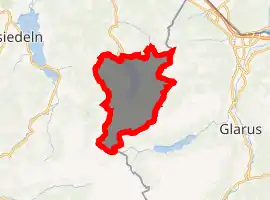
| |
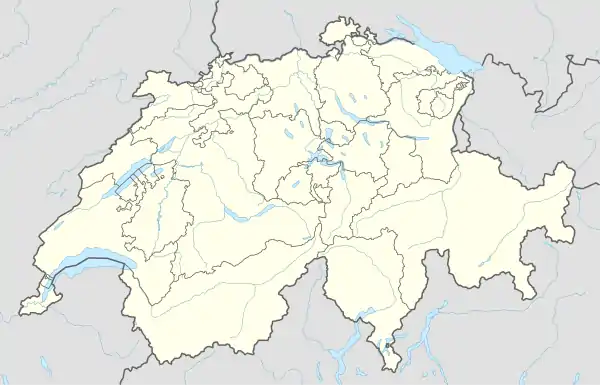 Innerthal 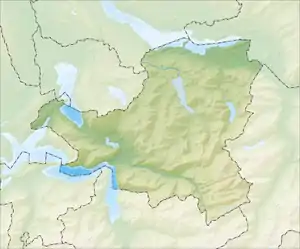 Innerthal | |
| Coordinates: 47°6′N 8°55′E | |
| Country | Switzerland |
| Canton | Schwyz |
| District | March |
| Area | |
| • Total | 50.22 km2 (19.39 sq mi) |
| Elevation | 915 m (3,002 ft) |
| Population (2018-12-31)[2] | |
| • Total | 173 |
| • Density | 3.4/km2 (8.9/sq mi) |
| Time zone | UTC+01:00 (Central European Time) |
| • Summer (DST) | UTC+02:00 (Central European Summer Time) |
| Postal code(s) | 8858 |
| SFOS number | 1343 |
| Localities | Wägitalersee |
| Surrounded by | Einsiedeln, Glarus (GL), Muotathal, Näfels (GL), Oberurnen (GL), Schübelbach, Unteriberg, Vorderthal |
| Website | www SFSO statistics |
History
Innerthal is first mentioned in 1259 as Wegental. Until 1888 it was known as Hinterwäggithal.[3]
Geography

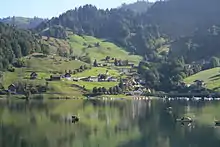
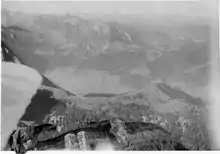
As of 2006 Innerthal has an area of 50.2 km2 (19.4 sq mi). Of this area, 34.9% is used for agricultural purposes, while 34.1% is forested. Of the rest of the land, 0.4% is settled (buildings or roads) and the remainder (30.6%) is non-productive (rivers, glaciers or mountains).[4]
The municipality is located on Wägitalersee, a reservoir in the upper Wägital.
Demographics
Innerthal has a population (as of 31 December 2019) of 177.[5] As of 2007, 2.1% of the population was made up of foreign nationals.[6] Over the last 10 years the population has grown at a rate of 5%. Most of the population (as of 2000) speaks German (97.0%), with Italian being second most common ( 1.8%) and Rhaeto-romance being third ( 0.6%).[4]
As of 2000 the gender distribution of the population was 48.5% male and 51.5% female. The age distribution, as of 2008, in Innerthal is; 46 people or 27.5% of the population is between 0 and 19. 44 people or 26.3% are 20 to 39, and 56 people or 33.5% are 40 to 64. The senior population distribution is 15 people or 9.0% are 65 to 74. There are 6 people or 3.6% who are 70 to 79 and no one is over 80.[6]
As of 2000 there are 64 households, of which 13 households (or about 20.3%) contain only a single individual. 5 or about 7.8% are large households, with at least five members.[6]
In the 2007 election the most popular party was the CVP which received 54.8% of the vote. The next three most popular parties were the SVP (28.3%), the FDP (13.8%) and the SPS (2.5%).[4]
The entire Swiss population is generally well educated. In Innerthal about 44.5% of the population (between age 25-64) have completed either non-mandatory upper secondary education or additional higher education (either university or a Fachhochschule).[4]
Innerthal has an unemployment rate of 0%. As of 2005, there were 22 people employed in the primary economic sector and about 10 businesses involved in this sector. 41 people are employed in the tertiary sector, with 8 businesses in this sector.[4]
From the 2000 census, 156 or 93.4% are Roman Catholic, while 8 or 4.8% belonged to the Swiss Reformed Church. There are less than 5 individuals who belong to no church, are agnostic or atheist, and less than 5 individuals did not answer the question.[6]
The historical population is given in the following table:[3]
| year | population |
|---|---|
| 1850 | 302 |
| 1900 | 363 |
| 1930 | (na |
| 1950 | 210 |
| 1990 | 151 |
| 2000 | 167 |
Weather
Innerthal has an average of 170.8 days of rain per year and on average receives 2,246 mm (88.4 in) of precipitation. The wettest month is June during which time Innerthal receives an average of 284 mm (11.2 in) of precipitation. During this month there is precipitation for an average of 17.1 days. The driest month of the year is October with an average of 131 mm (5.2 in) of precipitation over 17.1 days.[7]
References
- "Arealstatistik Standard - Gemeinden nach 4 Hauptbereichen". Federal Statistical Office. Retrieved 13 January 2019.
- "Ständige Wohnbevölkerung nach Staatsangehörigkeitskategorie Geschlecht und Gemeinde; Provisorische Jahresergebnisse; 2018". Federal Statistical Office. 9 April 2019. Retrieved 11 April 2019.
- Innerthal in German, French and Italian in the online Historical Dictionary of Switzerland.
- Swiss Federal Statistical Office Archived 2016-01-05 at the Wayback Machine accessed 02-Sep-2009
- "Ständige und nichtständige Wohnbevölkerung nach institutionellen Gliederungen, Geburtsort und Staatsangehörigkeit". bfs.admin.ch (in German). Swiss Federal Statistical Office - STAT-TAB. 31 December 2019. Retrieved 6 October 2020.
- Canton Schwyz Statistics Archived 2011-06-09 at the Wayback Machine (in German) accessed 27 August 2009
- "Temperature and Precipitation Average Values-Table, 1961-1990" (in German, French, and Italian). Federal Office of Meteorology and Climatology - MeteoSwiss. Archived from the original on 27 June 2009. Retrieved 8 May 2009., the weather station elevation is 908 meters above sea level.
External links
- Innerthal in German, French and Italian in the online Historical Dictionary of Switzerland.